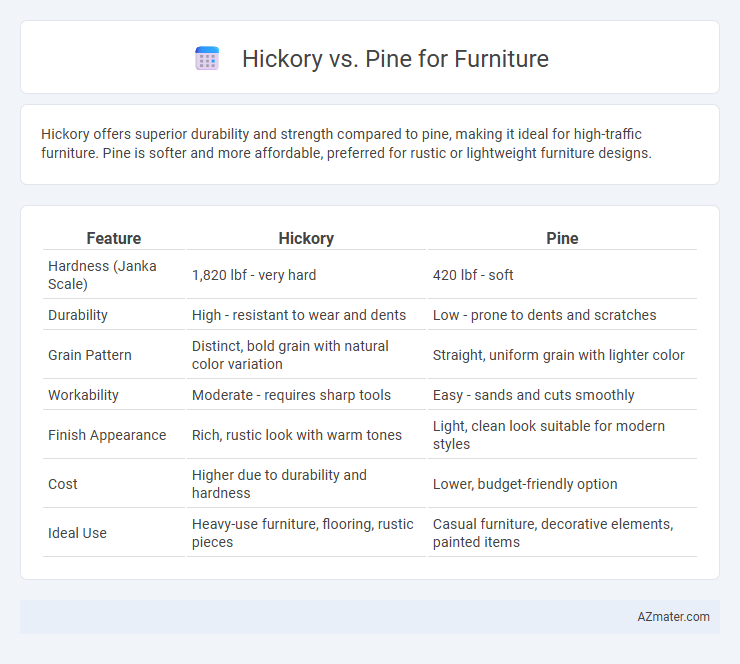Hickory offers superior durability and strength compared to pine, making it ideal for high-traffic furniture. Pine is softer and more affordable, preferred for rustic or lightweight furniture designs.
Table of Comparison
| Feature | Hickory | Pine |
|---|---|---|
| Hardness (Janka Scale) | 1,820 lbf - very hard | 420 lbf - soft |
| Durability | High - resistant to wear and dents | Low - prone to dents and scratches |
| Grain Pattern | Distinct, bold grain with natural color variation | Straight, uniform grain with lighter color |
| Workability | Moderate - requires sharp tools | Easy - sands and cuts smoothly |
| Finish Appearance | Rich, rustic look with warm tones | Light, clean look suitable for modern styles |
| Cost | Higher due to durability and hardness | Lower, budget-friendly option |
| Ideal Use | Heavy-use furniture, flooring, rustic pieces | Casual furniture, decorative elements, painted items |
Introduction: Hickory vs Pine for Furniture
Hickory and pine are popular wood choices for furniture, each offering distinct benefits in durability and appearance. Hickory is a dense hardwood known for its strength and rich, varied grain patterns, making it ideal for high-traffic furniture pieces. Pine, a softwood with a lighter color and smoother texture, is favored for its affordability and ease of customization in rustic or casual furniture designs.
Wood Characteristics and Appearance
Hickory wood is known for its exceptional hardness and durability, making it ideal for furniture that withstands heavy use, while pine is softer and offers more flexibility in design but is prone to dents and scratches. Hickory features a rich, varied grain with strong contrasts and warm reddish-brown tones, providing a rustic, robust appearance, whereas pine displays a lighter, pale yellow to creamy color with a smoother, more uniform texture and prominent knots that create a casual or country-style look. The density and toughness of hickory lend a weightier, long-lasting quality to furniture pieces, contrasting with pine's lighter weight and affordability, which suits less demanding environments or decorative items.
Durability and Strength Comparison
Hickory offers superior durability and strength compared to pine, making it an ideal choice for heavy-use furniture due to its dense, shock-resistant grain structure. Pine, being a softer wood, is more prone to dents and scratches, which diminishes its longevity under frequent use. For furniture that requires long-lasting resilience, hickory's hardness rating on the Janka scale (1,820) significantly exceeds pine's, which ranges from 380 to 870 depending on the species.
Workability and Ease of Crafting
Hickory wood offers superior durability and strength but presents challenges in workability due to its hardness and density, requiring sharper tools and more effort during crafting. Pine, being softer and lighter, allows for easier cutting, shaping, and sanding, making it a preferred choice for beginners and intricate woodworking. The choice between hickory and pine depends on balancing the need for robust furniture against the ease of crafting and finishing.
Cost and Affordability
Hickory furniture generally costs more than pine due to its greater density, hardness, and durability, which translates into longer-lasting pieces ideal for heavy-use areas. Pine is more affordable and widely available, making it a popular choice for budget-conscious buyers seeking lightweight and easy-to-work wood. For cost-effective furniture options, pine offers lower initial investment, while hickory provides better long-term value through enhanced strength and resistance to wear.
Finishing and Staining Differences
Hickory wood's dense grain and natural color variation create a striking, rustic finish that enhances rich stains and hides surface imperfections, making it ideal for durable, high-contrast furniture finishes. Pine, being softer with a more uniform grain, accepts paint and lighter stains evenly but is more prone to dents and color blotching during staining, requiring pre-treatment or sealers for smooth results. Choosing between Hickory and Pine depends on the desired aesthetic durability; Hickory offers longevity with dynamic finishes, while Pine provides a softer, more consistent base for painted or lightly stained furniture.
Environmental Impact and Sustainability
Hickory and pine differ significantly in environmental impact and sustainability, with pine being a faster-growing softwood that requires fewer resources and less time to mature, making it more sustainable for furniture production. Hickory, a dense hardwood, grows slower and demands more energy-intensive processing, which can increase its carbon footprint. Choosing pine furniture supports sustainable forestry practices and lower environmental costs compared to the higher resource intensity associated with hickory.
Maintenance and Longevity
Hickory furniture is highly durable and resistant to wear, requiring minimal maintenance beyond regular dusting and occasional oiling to preserve its natural finish. Pine furniture, while softer and more prone to dents and scratches, benefits from frequent sealing or waxing to protect its surface and extend its lifespan. Both woods can last decades when properly cared for, but hickory's hardness and density generally offer superior longevity and less intensive upkeep.
Best Furniture Types for Hickory and Pine
Hickory is best suited for heavy-use furniture like dining tables, chairs, and floors due to its exceptional hardness and durability, offering superior resistance to dents and scratches. Pine, being softer and lighter, excels in bedroom furniture such as bed frames, dressers, and bookshelves, providing a rustic aesthetic with ease of customization and cost-effectiveness. Both woods are popular choices, but hickory's strength suits dynamic living spaces while pine caters to decorative and lightweight applications.
Conclusion: Choosing the Right Wood for Your Furniture
Hickory offers exceptional durability and a rich, warm color that is ideal for heavy-use furniture, while pine delivers affordability and a lighter, rustic aesthetic perfect for casual or decorative pieces. Consider hickory for long-lasting, high-traffic items like dining tables or chairs, and pine for budget-friendly, lightweight furniture such as shelves or accent tables. Selecting between hickory and pine depends on your priority for strength versus cost and desired style in your furniture design.

Infographic: Hickory vs Pine for Furniture
 azmater.com
azmater.com